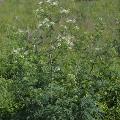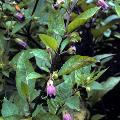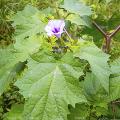ATTRACTING WILDLIFE.
Use plants to bring birds and pollinators to your property.
When frost and snow start to blanket the ground, many of us like to curl up with seed catalogs to plan next year’s garden. Planning ahead can have a huge impact on the types of wildlife your garden attracts (or doesn’t).
Plants provide food, shelter, and breeding habitat for all kinds of creatures. In return, these animals disperse seeds, pollinate flowers, and prune the plants around them. Sometimes a single species of plant is vital to the survival of a creature. However, many plants — particularly plants that are native to your area — offer safe haven to multiple species of birds, insects, and animals.
Almost any native fruit- or berry-bearing plant will attract bees, butterflies, and other pollinators when blooming and other wildlife as the fruit ripens. If the flower is red, hummingbirds will likely buzz in for nectar.
Some native plants are attractive not only to wildlife but also to people. For example, the serviceberry is a visually appealing native shrub that has white flowers in the spring, purple berries in summer, and red leaves in the fall. It also teems with interesting creatures. “Service- berries are important to bees, moths, and other pollinators as a nectar source,” says Joe Marcus, collections manager for the Lady Bird Johnson Wildflower Center in Austin, Texas. “Birds and squirrels nest in serviceberries. You might see a summer tanager or an oriole in their mid-level branches. In the fall, a number of animals eat the fruit, including bears, raccoons, opossums, and deer.”
Got a deer problem? Marcus recommends using native grasses for landscaping, such as big bluestem, Indian grass, or switchgrass, which can be large and attractive. Grasses provide food and shelter for birds, mice, rabbits, and voles, but they do not attract deer. Deer tend to be browsers, not grazers, so they usually don’t eat grass.
Deer also won’t eat milkweed because its sap is poisonous to them. This common roadside plant is starting to appear in home gardens due to its relationship with the imperiled Monarch butterfly. “There are many native species of milkweed,” says Marcus. “All are important larval food and adult nectar for Monarchs.”
For a showy native flower, Marcus favors purple coneflowers and other members of the Echinacea family. “Finches and sparrows depend on the seed heads of Echinacea for food during the winter,” he explains. “It’s a great landscaping plant, very eye-catching.”
And then there are the plants that humans don’t find particularly pleasing but are attractive to birds and animals. For example, hackberry trees can be unpopular because they grow where people don’t want them and they’re fast growing, says Marcus. They are also “soft hardwoods” and more apt to have limbs break off in a storm. “But climbing mammals use them. Woodpeckers nest in them. Wrens look for insects on them. And their fruit is an important food source for migrating birds.”
Native plants are good for wildlife and easy to grow. They usually require less maintenance — water, fertilizer, and soil upgrades — and are “better adapted to normal climate variations such as cyclical drought,” says Marcus. “If you take the time to get to know your local plants, you’ll find ways to use them.”
For more information about the benefits of native plants, visit the League’s
“Lands Green, Waters Clean” Web site.
POISON PLANTS.
Recognize which plants to leave alone.
There are two common types of poisonous plants: those that cause an allergic reaction when they come in contact with your skin and those that cause illness or death when ingested.
Four plants that can cause an allergic reaction when touched are poison ivy and poison oak, which are found throughout the United States; poison sumac (also called Thunderwood), which is found in wet or flooded areas around the Great Lakes and across the East Coast; and various types of nettles, commonly found in most of the country. The first three cause an itchy rash; the fourth produces a burning sensation.
“There are lots of old wives tales about plants like poison ivy,” says Steve Baskauf, PhD, a senior lecturer in the Department of Biological Sciences at Vanderbilt University. In reality, their effects are not a mystery. “The mechanism is well-known. If you touch the plant, a chemical [urushiol oil] causes a reaction if you don’t quickly wash it off. You can still enjoy the outdoors if you know how to prevent the reaction.”
Knowing what each looks like is the key to avoiding them. The old saying, “Leaves of three, let it be” applies to both poison ivy and poison oak. The poison oak triplet has “lobbed” leaves that resemble those of an oak tree. Poison ivy leaves have variable shapes with a pointy tip. Poison sumac sports 7 to 13 leaf pairs, with a single leaf at the end, and red stems. Burning nettle and stinging nettle both have leaves with serrated edges and stinging hairs — and unlike poison ivy and its friends, nettle stings affect everyone.
No-touch plants, while literally irritating, are often native and have other positive attributes. Poison ivy, for example, provides food and shelter for a variety of animals.
When it comes to eating wild plants, don’t do it, Baskauf cautions. He created the Bioimages Web site to educate the public about poisonous plants after several children in Kentucky died from eating Jimson weed seeds. “I assume all plants are poisonous unless I know otherwise,” he says. “It’s not worth the risk.”
Baskauf is also cautious about self-harvesting herbs. “Things that are medicinal in small quantities can be poisonous in large doses,” he says. “Chamomile, which is a common tea, can be toxic if you drink too much.” As a plant matures, its toxicity can change too.
Baskauf points to pokeweed, which people use for salad greens when it first comes up. If you eat pokeweed leaves after they mature, they can make you sick, and the berries are lethal.
Here are some particularly poisonous wild plants to avoid:
 Poison hemlock: A non-native in the parsley family, this plant has purple spots on its stem, grows up to 10 feet tall, and produces clusters of small, white flowers in the spring. It grows near roadsides and wetlands and can be mistaken for wild carrot (Queen Anne’s Lace) or parsnip. Every part of the poison hemlock is toxic.
Poison hemlock: A non-native in the parsley family, this plant has purple spots on its stem, grows up to 10 feet tall, and produces clusters of small, white flowers in the spring. It grows near roadsides and wetlands and can be mistaken for wild carrot (Queen Anne’s Lace) or parsnip. Every part of the poison hemlock is toxic.
 Deadly nightshade: Tomatoes, peppers, and potatoes are all benign members of the nightshade family. Deadly nightshade — a large shrub with dark purple, bell-shaped flowers — is considered one of the most toxic plants in the Western hemisphere. It is also used for medicinal purposes, which you should not try at home.
Deadly nightshade: Tomatoes, peppers, and potatoes are all benign members of the nightshade family. Deadly nightshade — a large shrub with dark purple, bell-shaped flowers — is considered one of the most toxic plants in the Western hemisphere. It is also used for medicinal purposes, which you should not try at home.
 Jimson weed: Another member of the nightshade family, Jimson weed is a stinky, common pest in agricultural areas. It has trumpet-like flowers that fade to spiky seed bulbs. All parts of the plant, particularly the seeds, are poisonous to humans and livestock.
Jimson weed: Another member of the nightshade family, Jimson weed is a stinky, common pest in agricultural areas. It has trumpet-like flowers that fade to spiky seed bulbs. All parts of the plant, particularly the seeds, are poisonous to humans and livestock.
Lisa Densmore Ballard is an award-winning writer and photographer who covers a range of outdoor recreation and conservation topics. She plucks ripe wild huckleberries at every chance but only gets close to poison ivy with a camera lens. www.LisaDensmore.com